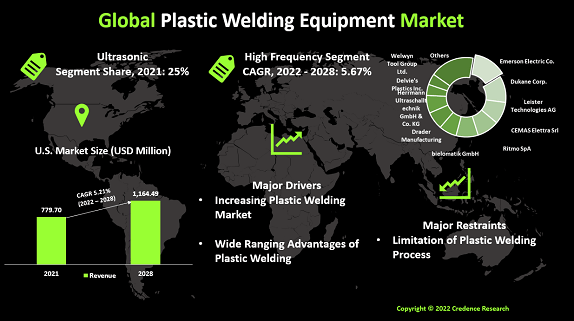1. Preface
1.1. Report Description
1.1.1. Purpose of the Report
1.1.2. Target Audience
1.1.3. USP and Key Offerings
1.2. Research Scope
1.3. Research Methodology
1.3.1. Phase I – Secondary Research
1.3.2. Phase II – Primary Research
1.3.3. Phase III – Expert Panel Review
1.3.4. Approach Adopted
1.3.4.1. Top-Down Approach
1.3.4.2. Bottom-Up Approach
1.3.5. Assumptions
1.4. Market Segmentation
2. Executive Summary
2.1. Market Snapshot: U.S. Plastic Welding Equipment Market
3. Market Dynamics & Factors Analysis
3.1. Introduction
3.1.1. U.S. Plastic Welding Equipment Market Value, 2016-2028, (US$ Bn)
3.2. Market Dynamics
3.2.1. Key Growth Trends
3.2.2. Major Industry Challenges
3.2.3. Key Growth Pockets
3.3. Attractive Investment Proposition,2021
3.3.1. Welding Method
3.3.2. Materials
3.4. Porter’s Five Forces Analysis
3.4.1. Threat of New Entrants
3.4.2. Bargaining Power of Buyers/Consumers
3.4.3. Bargaining Power of Suppliers
3.4.4. Threat of Substitute Welding Methods
3.4.5. Intensity of Competitive Rivalry
3.5. Value Chain Analysis
4. Market Positioning of Key Players, 2021
4.1. Company market share of key players, 2021
4.2. Top 6 Players
4.3. Top 3 Players
4.4. Major Strategies Adopted by Key Players
5. COVID 19 Impact Analysis
5.1. U.S. Plastic Welding Equipment Market Pre Vs Post COVID 19, 2019 – 2028
5.2. Impact on Import & Export
5.3. Impact on Demand & Supply
6. U.S.
6.1. U.S. Plastic Welding Equipment Market, by Welding Method, 2016-2028(US$ Bn)
6.1.1. Overview
6.1.2. Electric Socket
6.1.3. Ultrasonic
6.1.4. Hot Plate
6.1.5. Spin
6.1.6. Hot Gas
6.1.7. Extrusion
6.1.8. Injection
6.1.9. High Frequency
6.1.10. Laser
6.1.11. Others (Induction, Solvent etc.)
6.2. U.S. Plastic Welding Equipment Market, by Welding Method, 2016-2028(US$ Bn)
6.2.1. Overview
6.2.2. Polyethylene terephthalate (PET)
6.2.3. Polyethylene terephthalate glycol-modified (PETG)
6.2.4. Polyvinyl chloride (PVC)
6.2.5. Polypropylene (PP)
6.2.6. Thermoplastic polyurethane elastomers (TPUR)
6.2.7. Polyurethane (PU)
6.2.8. Low density polyethylene (LDPE)
6.2.9. Others
7. Company Profiles
7.1. Emerson Electric Co.
7.2. Dukane Corp.
7.3. Leister Technologies AG
7.4. CEMAS Elettra Srl
7.5. Ritmo SpA
7.6. bielomatik GmbH
7.7. Drader Manufacturing
7.8. Herrmann Ultraschalltechnik GmbH & Co. KG
7.9. Delvie’s Plastics Inc.
7.10. Welwyn Tool Group Ltd.
7.11. Others
List of Figures
FIG. 1 U.S. Plastic Welding Equipment Market: Research Methodology
FIG. 2 Market Size Estimation – Top Down & Bottom up Approach
FIG. 3 U.S. Plastic Welding Equipment Market Segmentation
FIG. 4 U.S. Plastic Welding Equipment Market, by Welding Method, 2019 (US$ Bn)
FIG. 5 Attractive Investment Proposition, by Welding Method, 2021
FIG. 6 U.S. Market Positioning of Key Plastic Welding Equipment Market Manufacturers, 2019
FIG. 7 U.S. Plastic Welding Equipment Market Value Contribution, By Welding Method, 2021 & 2028 (Value %)
FIG. 8 U.S. Plastic Welding Equipment Market, by Electric Socket, Value, 2016-2028 (US$ Bn)
FIG. 9 U.S. Plastic Welding Equipment Market, by Ultrasonic, Value, 2016-2028 (US$ Bn)
FIG. 10 U.S. Plastic Welding Equipment Market, by Hot Plate, Value, 2016-2028 (US$ Bn)
FIG. 11 U.S. Plastic Welding Equipment Market, by Spin, Value, 2016-2028 (US$ Bn)
FIG. 12 U.S. Plastic Welding Equipment Market, by Hot Gas, Value, 2016-2028 (US$ Bn)
FIG. 13 U.S. Plastic Welding Equipment Market, by Extrusion, Value, 2016-2028 (US$ Bn)
FIG. 14 U.S. Plastic Welding Equipment Market, by Injection, Value, 2016-2028 (US$ Bn)
FIG. 15 U.S. Plastic Welding Equipment Market, by High Frequency, Value, 2016-2028 (US$ Bn)
FIG. 16 U.S. Plastic Welding Equipment Market, by Laser, Value, 2016-2028 (US$ Bn)
FIG. 17 U.S. Plastic Welding Equipment Market, by Others (Induction, Solvent etc.), Value, 2016-2028 (US$ Bn)













